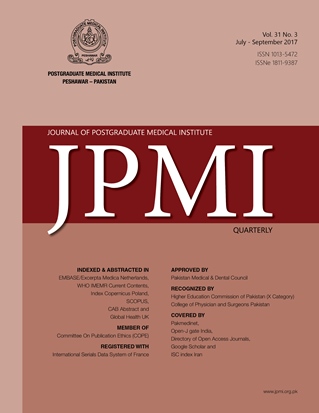SURGICAL OUTCOME OF CORPECTOMY, BONE GRAFTING AND CASPAR PLATING IN NON-TRAUMATIC CERVICAL SPINE DISEASES
Main Article Content
Abstract
Objective: To determine the neurological outcome in non-traumatic cervical
spine diseases after corpectectomy, bone grafting and Caspar plating.
Methods: Patients presenting with cervical spine diseases were included in this
descriptive study. Patients' demographic profiles, symptoms, signs and imaging
findings were recorded. The corpectomy was performed through anterior
approach. The bone graft was taken from iliac crest. The graft was shaped according to the size and fixed in position with Caspar and screws. Post op. check
x-rays were carried out to confirm the position of graft and hardware. Eighty
one patients were studied during 3 years.
Results: Out of 81 patients, 53 were male while 28 were female; age ranged
from18 to 60 years with mean age of 43.44 ±12.52 years. 35(43.2%) patients
had cervical spine stenosis secondary to osteophyte and hard disc, 15(18.5%)
patients had cervical stenosis with soft discs at multiple levels, 10(12.3%) patients
had ossified posterior longitudinal ligaments, 10(12.3%) patients had
collapsed vertebra secondary to metastasis, 7(8.6%) patients had collapsed vertebra secondary to plasmacytoma and 4(4.9%) patients had collapsed vertebra
secondary to old carries spine. Ninety percent of patients presented with neck
pain, brachalgia, quadriaparesis and urinary retention. Pain was relieved in all
patients (100%). Motor deficit recovered in 70 patients (86.41%).
Conclusion: In our study corpectomy, bone grafting and fixation with Casper
plating had a good neurological outcome in non-traumatic diseases of lower
cervical spine.
spine diseases after corpectectomy, bone grafting and Caspar plating.
Methods: Patients presenting with cervical spine diseases were included in this
descriptive study. Patients' demographic profiles, symptoms, signs and imaging
findings were recorded. The corpectomy was performed through anterior
approach. The bone graft was taken from iliac crest. The graft was shaped according to the size and fixed in position with Caspar and screws. Post op. check
x-rays were carried out to confirm the position of graft and hardware. Eighty
one patients were studied during 3 years.
Results: Out of 81 patients, 53 were male while 28 were female; age ranged
from18 to 60 years with mean age of 43.44 ±12.52 years. 35(43.2%) patients
had cervical spine stenosis secondary to osteophyte and hard disc, 15(18.5%)
patients had cervical stenosis with soft discs at multiple levels, 10(12.3%) patients
had ossified posterior longitudinal ligaments, 10(12.3%) patients had
collapsed vertebra secondary to metastasis, 7(8.6%) patients had collapsed vertebra secondary to plasmacytoma and 4(4.9%) patients had collapsed vertebra
secondary to old carries spine. Ninety percent of patients presented with neck
pain, brachalgia, quadriaparesis and urinary retention. Pain was relieved in all
patients (100%). Motor deficit recovered in 70 patients (86.41%).
Conclusion: In our study corpectomy, bone grafting and fixation with Casper
plating had a good neurological outcome in non-traumatic diseases of lower
cervical spine.
Article Details
How to Cite
1.
Khalid M, Farooq U, Ahmed E, Khaleeq S, Uz Zaman K. SURGICAL OUTCOME OF CORPECTOMY, BONE GRAFTING AND CASPAR PLATING IN NON-TRAUMATIC CERVICAL SPINE DISEASES. J Postgrad Med Inst [Internet]. 2017 Aug. 10 [cited 2025 Dec. 5];31(3). Available from: https://jpmi.org.pk/index.php/jpmi/article/view/2109
Issue
Section
Original Article
Work published in JPMI is licensed under a
Creative Commons Attribution-NonCommercial 2.0 Generic License.
Authors are permitted and encouraged to post their work online (e.g., in institutional repositories or on their website) prior to and during the submission process, as it can lead to productive exchanges, as well as earlier and greater citation of published work.


